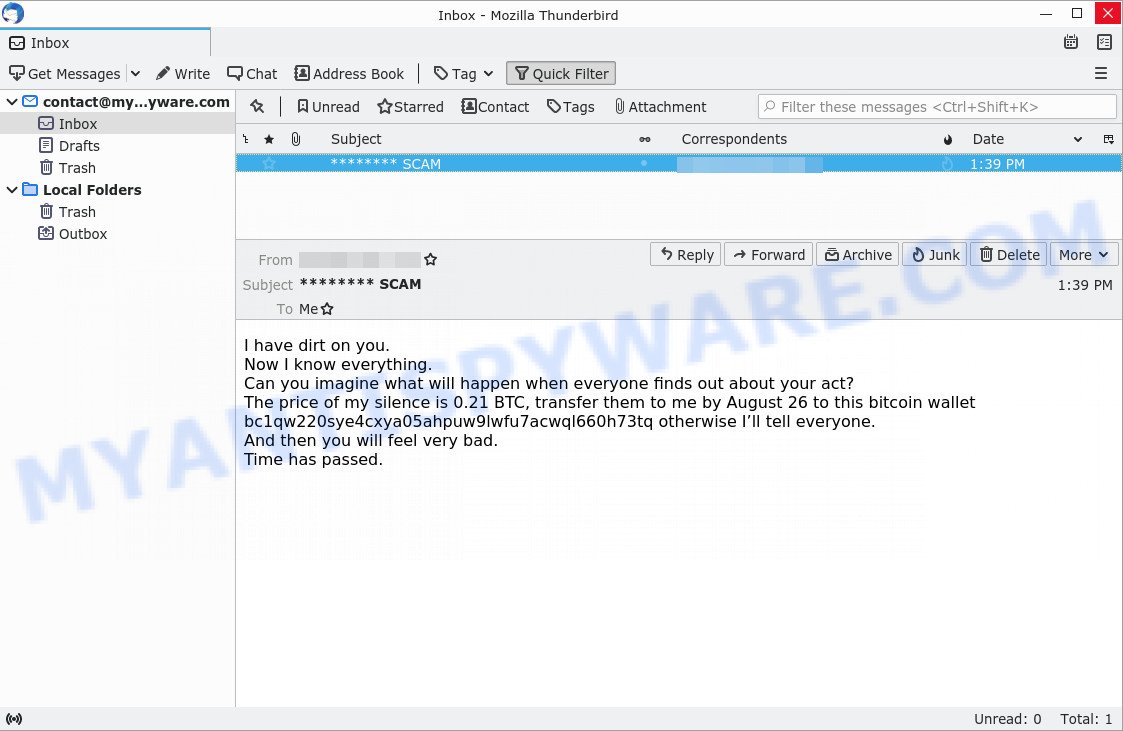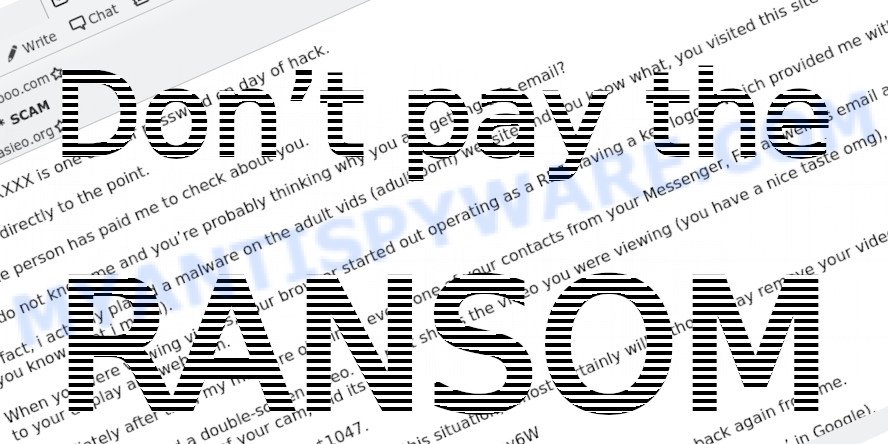What is I have dirt on you. Now I know everything. SCAM?
I have dirt on you. Now I know everything. is a new ‘extortion’ scam. Extortion scams are designed to scare victims into handing over money without seeking any further information and assistance. Criminals usually contact potential victims through email, but in some cases, criminals can use online web forms, whatsapp and sms messages. The scammers claim that they obtained material compromising victims’ reputations. It should be emphasized that any statements, claims and threats contained in the ‘extortion’ scams are false.

The “I have dirt on you. Now I know everything.” message is a new SCAM
QUICK LINKS
- What is I have dirt on you. Now I know everything. SCAM?
- Should you pay?
- What to do when you receive the scam message?
The “I have dirt on you. Now I know everything.” message informs that the sender knows some information that could potentially harm the recipient. The sender threatens to share this information with everyone unless the victim pays the ransom to the bitcoin address provided in the message. As stated above, the message is just an extortion scam. All claims and threats made in this message are false. Therefore, recipients are not in danger, the message and similar messages can be safely ignored.
Typically, extortion scams are sent via email, thousands at a time, and are part of larger spam campaigns. As with many other types of scams, scammers are evolving their methods to deliver their messages to potential victims. Such attacks can be personalized and sent out in smaller numbers to avoid detection. Scammers can use reputable services, change and personalize the content of each message, and avoid including links or attachments – all in an attempt to bypass security.
Text presented in the “I have dirt on you. Now I know everything.” message:
I have dirt on you.
Now I know everything.
Can you imagine what will happen when everyone finds out about your act?
The price of my silence is 0.21 BTC, transfer them to me by August 26 to this bitcoin wallet bc1qw220sye4cxya05ahpuw9lwfu7acwql660h73tq otherwise I’ll tell everyone.
And then you will feel very bad.
Time has passed.
Should you pay?

The best advice is: Don’t pay the ransom! If you receive the sextortion email scam, just ignore the scammers’ empty threats. The best way to deal with the scam email is simply to move it to trash!
Threat Summary
| Name | I have dirt on you. Now I know everything. SCAM |
| Type | Extortion, Phishing, Bitcoin Email Scam, Fraud, Scam |
| Email subject line | Money Transfer Confirmation. |
| Ransom amount | 0.21 BTC |
| Bitcoin Address | bc1qw220sye4cxya05ahpuw9lwfu7acwql660h73tq |
| Distribution method | spam email campaigns |
| Removal | If you gets an email like I have dirt on you. Now I know everything., our computer security experts recommend follow some easy steps below |
There are many types of the scam, scammers often change the text of messages in order to deceive victims and bypass security systems. In addition, in some cases, criminals can translate the text of extortion messages into other languages, thus targeting a specific group of Internet users. Greetings! This email has nothing good for you, I am sorry to inform you that your device was compromised, I have to share bad news with you are other examples of extortion scams. Such messages are also often used to distribute ransomware, trojans, worms and other malware.
What to do when you receive the I have dirt on you. Now I know everything. SCAM
We advice to someone who gets this fraudulence message:
- Do not panic.
- Don’t even think this message is true.
- If you receive a message from someone threatening you and asking you to pay a ransom, do not respond. Just delete this message.
- If there’s a link in the scam email, do not click it, otherwise you could unwittingly install malware or ransomware on your computer.
- Report the email spam to the FTC at https://www.ftc.gov/
- Do not respond to scam messages or emails.
- Scan your computer for malware.
- Install an anti-phishing software.
How to scan your computer for malware
If you suspect that your computer is infected with malware, you accidentally clicked on a link in the scam email, or just want to scan your computer, then use one of the best free malware removal tools. One of these utilities is Zemana Anti Malware. It is a lightweight utility which designed to use alongside your antivirus software, detecting and removing malicious software, adware and PUPs that other security tools miss. Zemana Anti Malware is easy to use, fast, does not use many resources and have great detection and removal rates.
Please go to the following link to download the latest version of Zemana for Windows. Save it on your desktop.
164806 downloads
Author: Zemana Ltd
Category: Security tools
Update: July 16, 2019
When downloading is complete, close all programs and windows on your PC. Double-click the set up file called Zemana.AntiMalware.Setup. If the “User Account Control” dialog box pops up as displayed in the following example, click the “Yes” button.

It will open the “Setup wizard” that will help you install Zemana on your PC. Follow the prompts and do not make any changes to default settings.

Once installation is complete successfully, Zemana Anti Malware will automatically start and you can see its main screen as shown on the image below.

Now click the “Scan” button to perform a system scan for malware. While Zemana is scanning the system, you can see how many objects it has identified either as being malware.

After Zemana completes the scan, It will display a screen which contains a list of malware that has been detected. Next, you need to click “Next” button. It will start to remove malicious software. When finished, you may be prompted to restart the system.
If you are having issues with malware removal, then check out MalwareBytes. We recommend this free malware removal utility because it may easily delete trojans, spyware, browser hijackers, adware, potentially unwanted software and toolbars with all their components such as files, folders and registry entries. Visit the page linked below to download the latest version of MalwareBytes Anti-Malware for Windows.
327057 downloads
Author: Malwarebytes
Category: Security tools
Update: April 15, 2020
We suggest you look at the following video, which completely explains the process of using the MalwareBytes Anti Malware to remove malicious software.
How to protect yourself from phishing, malicious and misleading websites
If you want to protect yourself from phishing websites, then install an ad blocker program such as AdGuard. It can block malicious and misleading web sites, stop unwanted advertisements and popups when using the Internet Explorer, Google Chrome, Firefox and Edge. So, if you like surf the Internet, and want to protect your computer from malicious web pages, then the AdGuard is your best choice.
Installing the AdGuard is simple. First you’ll need to download AdGuard by clicking on the link below.
26841 downloads
Version: 6.4
Author: © Adguard
Category: Security tools
Update: November 15, 2018
After downloading it, double-click the downloaded file to start it. The “Setup Wizard” window will show up on the computer screen as displayed below.

Follow the prompts. AdGuard will then be installed and an icon will be placed on your desktop. A window will show up asking you to confirm that you want to see a quick guide as displayed on the screen below.

Click “Skip” button to close the window and use the default settings, or press “Get Started” to see an quick guidance which will assist you get to know AdGuard better.
Each time, when you start your system, AdGuard will start automatically and stop unwanted advertisements, block phishing, as well as other harmful or misleading websites. For an overview of all the features of the application, or to change its settings you can simply double-click on the AdGuard icon, which can be found on your desktop.
Finish words
If you receive ascam message that is similar but not the same as the example above, make sure you remove any personal info in this message, then post it as comment on this article. This helps us to warn users about current scams, monitor trends and disrupt scams where possible.



















